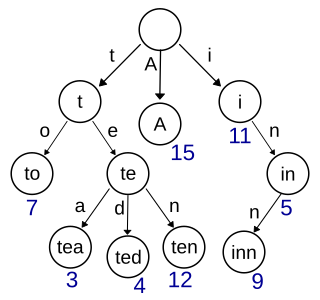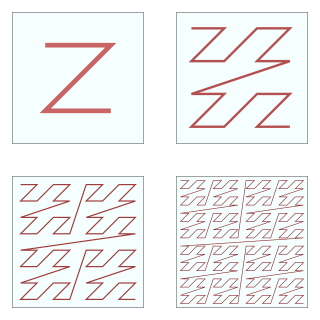Related Research Articles
In computer science, a B-tree is a self-balancing tree data structure that maintains sorted data and allows searches, sequential access, insertions, and deletions in logarithmic time. The B-tree generalizes the binary search tree, allowing for nodes with more than two children. Unlike other self-balancing binary search trees, the B-tree is well suited for storage systems that read and write relatively large blocks of data, such as databases and file systems.

A hash function is any function that can be used to map data of arbitrary size to fixed-size values, though there are some hash functions that support variable length output. The values returned by a hash function are called hash values, hash codes, hash digests, digests, or simply hashes. The values are usually used to index a fixed-size table called a hash table. Use of a hash function to index a hash table is called hashing or scatter storage addressing.

In computing, a hash table, also known as a hash map or a hash set, is a data structure that implements an associative array, also called a dictionary, which is an abstract data type that maps keys to values. A hash table uses a hash function to compute an index, also called a hash code, into an array of buckets or slots, from which the desired value can be found. During lookup, the key is hashed and the resulting hash indicates where the corresponding value is stored.

In computer science, a trie, also called digital tree or prefix tree, is a type of k-ary search tree, a tree data structure used for locating specific keys from within a set. These keys are most often strings, with links between nodes defined not by the entire key, but by individual characters. In order to access a key, the trie is traversed depth-first, following the links between nodes, which represent each character in the key.
In computer science, an associative array, map, symbol table, or dictionary is an abstract data type that stores a collection of pairs, such that each possible key appears at most once in the collection. In mathematical terms, an associative array is a function with finite domain. It supports 'lookup', 'remove', and 'insert' operations.
ISAM, an acronym for Indexed Sequential Access Method, is a method for creating, maintaining, and manipulating computer files of data so that records can be retrieved sequentially or randomly by one or more keys. Indexes of key fields are maintained to achieve fast retrieval of required file records in indexed files. IBM originally developed ISAM for mainframe computers, but implementations are available for most computer systems.
Kademlia is a distributed hash table for decentralized peer-to-peer computer networks designed by Petar Maymounkov and David Mazières in 2002. It specifies the structure of the network and the exchange of information through node lookups. Kademlia nodes communicate among themselves using UDP. A virtual or overlay network is formed by the participant nodes. Each node is identified by a number or node ID. The node ID serves not only as identification, but the Kademlia algorithm uses the node ID to locate values.
In computing, a persistent data structure or not ephemeral data structure is a data structure that always preserves the previous version of itself when it is modified. Such data structures are effectively immutable, as their operations do not (visibly) update the structure in-place, but instead always yield a new updated structure. The term was introduced in Driscoll, Sarnak, Sleator, and Tarjan's 1986 article.
Btrieve is a database developed by Pervasive Software. The architecture of Btrieve has been designed with record management in mind. This means that Btrieve only deals with the underlying record creation, data retrieval, record updating and data deletion primitives. Together with the MicroKernel Database Engine it uses ISAM, Indexed Sequential Access Method, as its underlying storage mechanism.
A B+ tree is an m-ary tree with a variable but often large number of children per node. A B+ tree consists of a root, internal nodes and leaves. The root may be either a leaf or a node with two or more children.

In mathematical analysis and computer science, functions which are Z-order, Lebesgue curve, Morton space-filling curve, Morton order or Morton code map multidimensional data to one dimension while preserving locality of the data points. It is named in France after Henri Lebesgue, who studied it in 1904, and named in the United States after Guy Macdonald Morton, who first applied the order to file sequencing in 1966. The z-value of a point in multidimensions is simply calculated by interleaving the binary representations of its coordinate values. Once the data are sorted into this ordering, any one-dimensional data structure can be used, such as simple one dimensional arrays, binary search trees, B-trees, skip lists or hash tables. The resulting ordering can equivalently be described as the order one would get from a depth-first traversal of a quadtree or octree.
A database index is a data structure that improves the speed of data retrieval operations on a database table at the cost of additional writes and storage space to maintain the index data structure. Indexes are used to quickly locate data without having to search every row in a database table every time said table is accessed. Indexes can be created using one or more columns of a database table, providing the basis for both rapid random lookups and efficient access of ordered records.
Linear hashing (LH) is a dynamic data structure which implements a hash table and grows or shrinks one bucket at a time. It was invented by Witold Litwin in 1980. It has been analyzed by Baeza-Yates and Soza-Pollman. It is the first in a number of schemes known as dynamic hashing such as Larson's Linear Hashing with Partial Extensions, Linear Hashing with Priority Splitting, Linear Hashing with Partial Expansions and Priority Splitting, or Recursive Linear Hashing.
In computer science, a ternary search tree is a type of trie where nodes are arranged in a manner similar to a binary search tree, but with up to three children rather than the binary tree's limit of two. Like other prefix trees, a ternary search tree can be used as an associative map structure with the ability for incremental string search. However, ternary search trees are more space efficient compared to standard prefix trees, at the cost of speed. Common applications for ternary search trees include spell-checking and auto-completion.
Nearest neighbor search (NNS), as a form of proximity search, is the optimization problem of finding the point in a given set that is closest to a given point. Closeness is typically expressed in terms of a dissimilarity function: the less similar the objects, the larger the function values.

A database model is a type of data model that determines the logical structure of a database. It fundamentally determines in which manner data can be stored, organized and manipulated. The most popular example of a database model is the relational model, which uses a table-based format.
Database tables and indexes may be stored on disk in one of a number of forms, including ordered/unordered flat files, ISAM, heap files, hash buckets, or B+ trees. Each form has its own particular advantages and disadvantages. The most commonly used forms are B-trees and ISAM. Such forms or structures are one aspect of the overall schema used by a database engine to store information.
In computer science, the Bx tree is a query that is used to update efficient B+ tree-based index structures for moving objects.
Rocket U2 is a suite of database management (DBMS) and supporting software now owned by Rocket Software. It includes two MultiValue database platforms: UniData and UniVerse. Both of these products are operating environments which run on current Unix, Linux and Windows operating systems. They are both derivatives of the Pick operating system. The family also includes developer and web-enabling technologies including SB/XA, U2 Web Development Environment (WebDE), UniObjects connectivity API and wIntegrate terminal emulation software.
References
- 1 2 J. Nievergelt, H. Hinterberger The Grid File: An Adaptable, Symmetric Multikey File Structure. Institut fur Informatik, ETH and K. C. Sevcik, 1984. Abstract, p. 1.
- ↑ Donald Knuth. The Art of Computer Programming, Volume 3: Sorting and Searching, Second Edition. Addison-Wesley, 1998. ISBN 0-201-89685-0. Section 6.5: Searching, pp. 564–566.
- ↑ Elmasri & Navathe Fundamentals of Database Systems, Third Edition. Addison-Wesley, 2000. ISBN 0-201-54263-3. Section 6.4.3: Grid Files, p. 185.
- 1 2 "Grid File". cs.sfu.ca. Retrieved 2016-11-27.